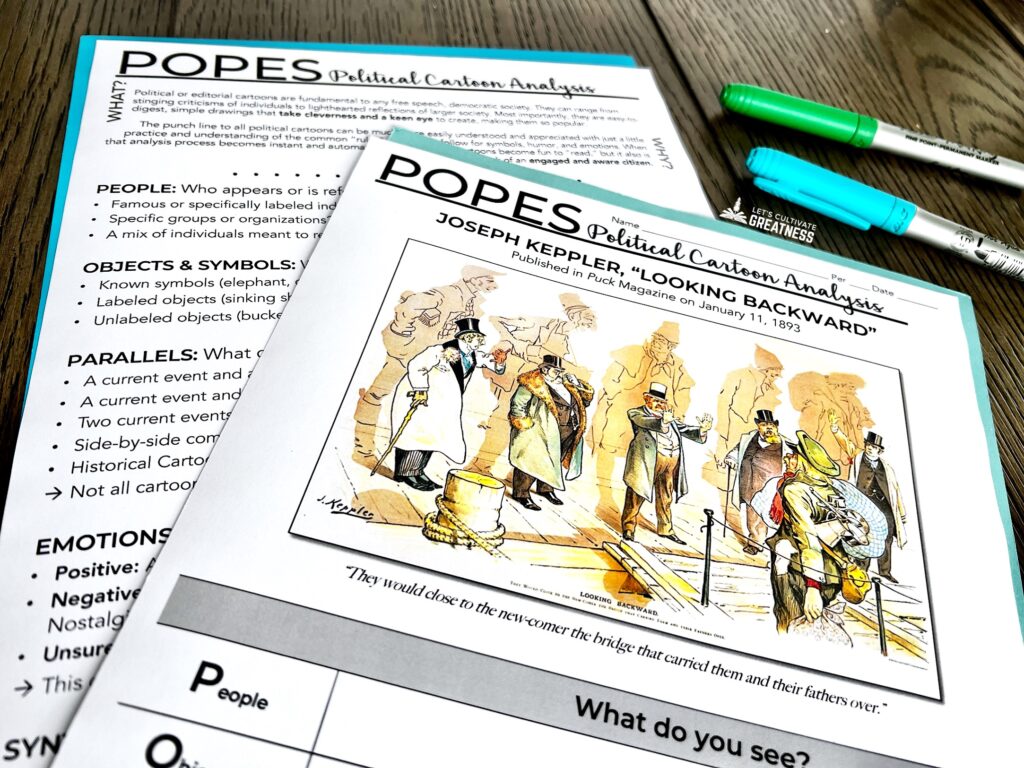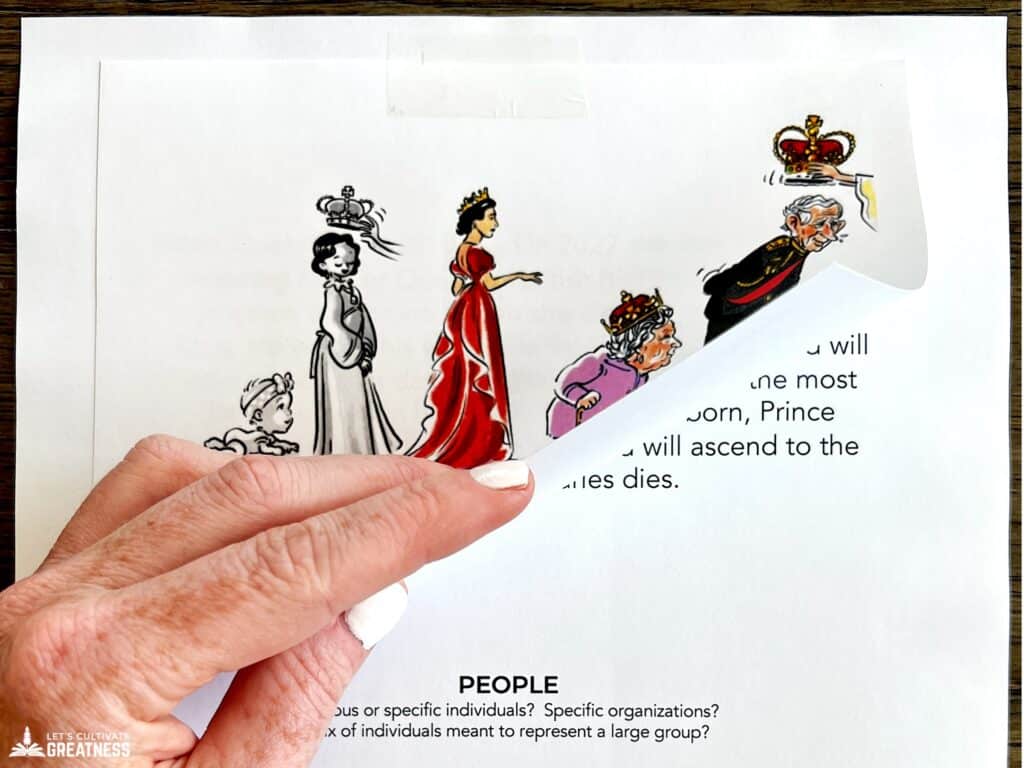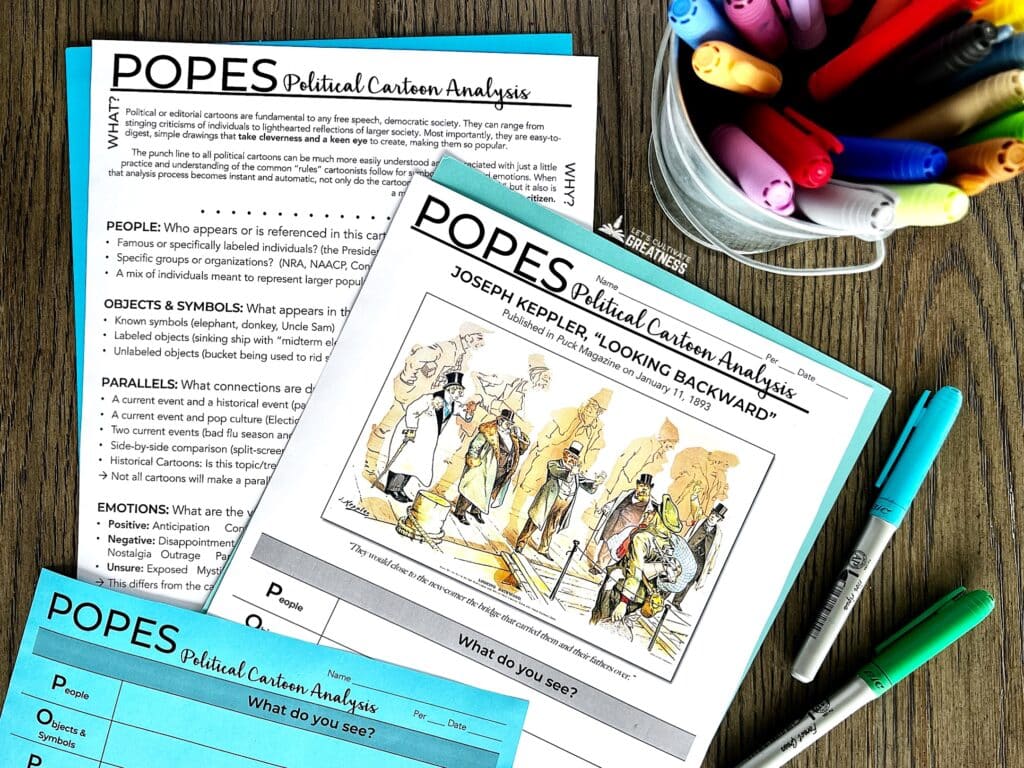Political cartoons are the perfect basis for so many civics activities and topics, regardless of ability level.
I think it’s because they are inherently not boring—they’re visual (not reading!), cover content through real-life events, and are humorous.
Over the years of teaching high school Civics and Government, I’ve used them in countless ways with my students. Here are my go-to favorite civics activities I use with political cartoons.
Hopefully, you’ll get some fresh lesson ideas for your class!
Finding Great Political Cartoons
First, we need to find some good cartoons.
Usually, only a few cartoons are perennial enough to use the following year, and I’m constantly swapping in fresh ones my students can best relate to. You’ll want to do this as well.
Here are my go-to spots for grabbing high-resolution political cartoons:
Daryl Cagle’s searchable database of current cartoons
The Week’s and US News’s collections of just-released cartoons
How to Teach Analyzing Cartoons
Next, students need a foundation for examining and understanding them.

Be sure to spend time teaching how to analyze political cartoons before your first lesson that uses them! My FREE Political Cartoon Analysis Kit is a complete how-to lesson that does this for you.
Now that students know how to process cartoons let’s dive into five easy mix-and-match activity ideas using them.
Unit Hooks
Post a provocative cartoon on the first day of your unit. Find one that’s extra critical of a topic or references a heavily debated issue related to the unit.
For example, I use one depicting voter apathy among young adults for my Voting & Elections unit or one about a recent Supreme Court ruling for my Civil Liberties unit.
Challenge students to generate questions in small groups. Lower-level questions are great to start—Who is that? What is that court case? Go over those answers.
Next, have them dig deeper with Is or Should questions —Is voter turnout for younger people really so much lower, or is that just a stereotype? When should people not have the right to do that? Questions that take a paragraph or more to answer.
Students will likely need some modeling here if they haven’t done much work with inquiry.
Write down, but don’t answer these questions. Ideally, by the end of your unit, students will learn content that will help them arrive at their own answers.
Post the cartoon and the questions somewhere visible in your classroom to refer back to throughout the unit, or save them in a Google Doc to revisit at the end of the unit.
Bell Ringers or Do Nows
This is the easiest and most obvious way. Certainly, it’s how I mainly used cartoons in my first years of teaching Civics. Cartoons are the perfect material for a 5-minute, start-of-class routine.
Post a cartoon on your screen as students walk in each day, providing them with a graphic organizer sheet to record their learning. I use worksheets that hold a week’s worth of cartoons.
As the bell rings, provide any background information students need to know to begin processing the cartoon. Then, as they go through the POPES process, you can take attendance.
When using cartoons as daily bell ringers, pick ones referencing timely current events to share about current political events and issues.
Gallery Walk
Whenever you find yourself teaching a collection of several things (like principles of the Constitution, types of government systems, or powers of Congress), use cartoons depicting them.
This is a perfect application-level activity after a lecture or a textbook reading covering the concepts.
Search a political cartoon database for the concepts you want to illustrate. For this, cartoons can totally be from a few years ago. Just be sure they aren’t referencing such obscure things that students will struggle. I will also write up some brief background information to put behind the cartoon for greater accessibility.

The trick is to pick cartoons that don’t explicitly have the concept written on them—for example, a cartoon dealing with a checks and balances issue without saying the phrase.
Copy and paste them onto full-size sheets and place them around the room. Shoot for one cartoon depicting each concept. For example, seven stations, each depicting one of the Constitution’s seven principles.
Have students rotate through each cartoon, completing one piece of the POPES analysis at each station.
Afterward, challenge students to identify which cartoon illustrates which concept.
4 Corners
Find four cartons that take on different attitudes about the same overarching concept. Like during your Voting and Election unit, viewpoints about voting turnout and access. Or your Three Branches unit, various critiques on how the branches operate in real life.
Copy and resize the cartoons to fill a full sheet of paper and place them in the four corners of your classroom.
Have students preview each cartoon (perhaps doing a quick POPES analysis), then decide which one they most agree with. Students then go to that cartoon.
Working in their groups, students brainstorm evidence learned in class on the topic supporting their cartoon’s perspective. Have them share with the rest of the class.
Deeper Analysis
If you don’t do daily bellringer cartoons, it’s a no-brainer to at least bring in a few especially powerful cartoons each unit. Use them to spark deeper thinking about the topic.
After completing a POPES analysis, pose some discussion questions that really connect the cartoon to the American identity, deep-rooted American values, or similar political events.
Here are some general questions you can tweak to fit any cartoon worth pondering a little deeper:
What American values are underlying here for this cartoon to have this message?
Would a different or opposite punchline still work, or would it be a violation of accepted American norms?
Who would most likely agree with this cartoon’s message?
Who might call this cartoon “un-American” or profoundly disagree with it?
When is another time when people have felt this way about this general topic or another topic?

I hope these ideas have sparked activity ideas for teaching civics topics with political cartoons, especially ones that support all your learners. Grab my FREE Political Cartoons Analysis Kit for a done-for-you starter kit to get going with teaching with cartoons!
Feature image photo credit: Roman Kraft





